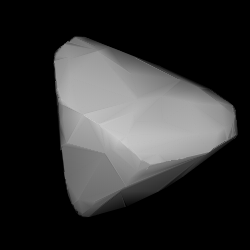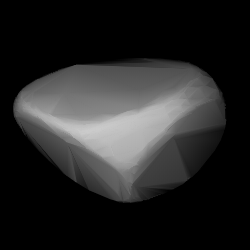Related Research Articles

1578 Kirkwood, provisional designation 1951 AT, is a Hilda asteroid from the outermost regions of the asteroid belt, approximately 52 kilometers in diameter. It was discovered on 10 January 1951, by astronomers of the Indiana Asteroid Program at Goethe Link Observatory in Indiana, United States. The asteroid was named after American astronomer Daniel Kirkwood.

748 Simeïsa is a very large Hilda asteroid from the outermost regions of the asteroid belt, approximately 104 kilometers in diameter. It was discovered on 14 March 1913, by Russian astronomer Grigory Neujmin at the Simeiz Observatory on the Crimean peninsula. The dark P-type asteroid has a rotation period of 11.9 hours and a shape that is reminiscent of a tetrahedron. It was the first asteroid discovery made in Russia and named after the discovering observatory and its nearby Crimean town, Simeiz.

1746 Brouwer is a Hilda asteroid from the outermost region of the asteroid belt, approximately 64 kilometers in diameter. It was discovered on 14 September 1963, by IU's Indiana Asteroid Program at Goethe Link Observatory near Brooklyn, Indiana, United States. It was named after astronomer Dirk Brouwer.
1180 Rita, provisional designation 1931 GE, is a dark and spheroidal Hildian asteroid from the outermost regions of the asteroid belt, approximately 97 kilometers in diameter. It was discovered on 9 April 1931, by German astronomer Karl Reinmuth at the Heidelberg Observatory in southwest Germany. Any reference of its later name, Rita, is unknown.
1144 Oda, provisional designation 1930 BJ, is a dark Hildian asteroid from the outermost regions of the asteroid belt, approximately 57 kilometers in diameter. It was discovered on 28 January 1930, by German astronomer Karl Reinmuth at the Heidelberg-Königstuhl State Observatory. The asteroid's name is a German female name, not related to the discoverer's contemporaries.
1268 Libya, provisional designation 1930 HJ, is a dark Hildian asteroid from the outer regions of the asteroid belt, approximately 95 kilometers in diameter. It was discovered on 29 April 1930, by South African astronomer Cyril Jackson at the Union Observatory in Johannesburg, South Africa. The asteroid was named for the country Libya.
2067 Aksnes, provisional designation 1936 DD, is a rare-type Hildian asteroid from the outermost region of the asteroid belt, approximately 44 kilometers in diameter. The asteroid was discovered on 23 February 1936, by Finnish astronomer Yrjö Väisälä at Turku Observatory in Southwest Finland. It was named after astronomer Kaare Aksnes.
3254 Bus, provisional designation 1982 UM, is a rare-type Hildian asteroid from the outermost region of the asteroid belt, approximately 32 kilometers in diameter. It was discovered on 17 October 1982, by American astronomer Edward Bowell at Lowell's Anderson Mesa Station in Flagstaff, Arizona. It is named after astronomer Schelte J. Bus.
1212 Francette, provisional designation 1931 XC, is a dark Hildian asteroid from the outermost regions of the asteroid belt, approximately 82 kilometers in diameter. It was discovered on 3 December 1931, by French astronomer Louis Boyer at the Algiers Observatory in Algeria, North Africa, who named it after his wife Francette Boyer.

2483 Guinevere is a dark and elongated Hilda asteroid from the outermost regions of the asteroid belt, approximately 43 kilometers in diameter. The asteroid was discovered on 17 August 1928, by German astronomer Max Wolf at Heidelberg Observatory in southwest Germany and given the provisional designation 1928 QB. In the 1980s, it was named after King Arthur's wife Guinevere.
1748 Mauderli, provisional designation 1966 RA, is a dark and very reddish Hildian asteroid from the outermost region of the asteroid belt, approximately 45 kilometers in diameter.

1256 Normannia is a dark Hilda asteroid and slow rotator from the outermost regions of the asteroid belt, approximately 69 kilometers in diameter. It was discovered on 8 August 1932, by astronomer Karl Reinmuth at the Heidelberg-Königstuhl State Observatory in Germany. The asteroid was likely named after the Normans who gave their name to the region of Normandy in France.
1529 Oterma, provisional designation 1938 BC, is a reddish, rare-type Hildian asteroid from the outermost region of the asteroid belt, approximately 56 kilometers in diameter. It was discovered on 26 January 1938, by Finnish astronomer Yrjö Väisälä at Turku Observatory in Southwest Finland. It is named for Liisi Oterma.

1512 Oulu, provisional designation 1939 FE, is a dark Hildian asteroid, slow rotator and possibly the largest known tumbler orbiting in the outermost region of the asteroid belt. With a diameter of approximately 80 kilometers, it belongs to the fifty largest asteroids in the outer main-belt. The body was discovered on 18 March 1939, by Finnish astronomer Heikki Alikoski at Turku Observatory in Southwest Finland and named for the Finnish town Oulu.
1345 Potomac, provisional designation 1908 CG, is a dark Hildian asteroid from the outermost regions of the asteroid belt, approximately 73 kilometers (45 mi) in diameter. It was discovered on 4 February 1908, by American astronomer Joel Metcalf at the Taunton Observatory in Massachusetts, United States. The X-type asteroid has a rotation period of 11.4 hours. It was named for the Potomac River on which Washington, D.C. is located.
2959 Scholl, provisional designation 1983 RE2, is a carbonaceous Hildian asteroid from the outer regions of the asteroid belt, approximately 34 kilometers in diameter. It was discovered on 4 September 1983 by English–American astronomer Edward Bowell of the Lowell Observatory at Anderson Mesa Station near Flagstaff, Arizona. The asteroid was named after German astronomer Hans Scholl.
1911 Schubart, provisional designation 1973 UD, is a dark Hildian asteroid and parent body of the Schubart family, located in the outermost region of the asteroid belt, approximately 70 kilometers in diameter. It was discovered on 25 October 1973, by Swiss astronomer Paul Wild at Zimmerwald Observatory, near Bern, Switzerland. The asteroid was named after German astronomer Joachim Schubart.

1902 Shaposhnikov is a dark Hilda asteroid from the outermost region of the asteroid belt, approximately 92 kilometers in diameter. It was discovered on 18 April 1972, by Russian astronomer Tamara Smirnova at the Crimean Astrophysical Observatory in Nauchnyj, on the Crimean peninsula. The asteroid was named after Soviet astronomer and WWII casualty Vladimir Shaposhnikov. It was one of the last larger asteroids discovered in the main belt.
1941 Wild, provisional designation 1931 TN1, is an eccentric Hildian asteroid from the outermost region of the asteroid belt, approximately 20 kilometers in diameter.
1439 Vogtia, provisional designation 1937 TE, is a dark Hildian asteroid from the outermost region of the asteroid belt, approximately 48 kilometers in diameter. It was discovered on 11 October 1937, by German astronomer Karl Reinmuth at Heidelberg Observatory in southern Germany. It is named for astronomer Heinrich Vogt.
References
- 1 2 3 4 5 6 7 8 9 "JPL Small-Body Database Browser: 1162 Larissa (1930 AC)" (2017-07-05 last obs.). Jet Propulsion Laboratory . Retrieved 7 September 2017.
- ↑ Noah Webster (1884) A Practical Dictionary of the English Language
- 1 2 3 Schmadel, Lutz D. (2007). "(1162) Larissa". Dictionary of Minor Planet Names. Springer Berlin Heidelberg. p. 98. doi:10.1007/978-3-540-29925-7_1163. ISBN 978-3-540-00238-3.
- 1 2 3 4 5 6 7 "LCDB Data for (1162) Larissa". Asteroid Lightcurve Database (LCDB). Retrieved 7 September 2017.
- 1 2 "Asteroid 1162 Larissa – Proper Elements". AstDyS-2, Asteroids – Dynamic Site. Retrieved 28 October 2019.
- 1 2 3 4 5 6 7 8 Grav, T.; Mainzer, A. K.; Bauer, J.; Masiero, J.; Spahr, T.; McMillan, R. S.; et al. (January 2012). "WISE/NEOWISE Observations of the Hilda Population: Preliminary Results". The Astrophysical Journal. 744 (2): 15. arXiv: 1110.0283 . Bibcode:2012ApJ...744..197G. doi:10.1088/0004-637X/744/2/197. S2CID 44000310 . Retrieved 7 September 2017.
- 1 2 3 4 Usui, Fumihiko; Kuroda, Daisuke; Müller, Thomas G.; Hasegawa, Sunao; Ishiguro, Masateru; Ootsubo, Takafumi; et al. (October 2011). "Asteroid Catalog Using Akari: AKARI/IRC Mid-Infrared Asteroid Survey". Publications of the Astronomical Society of Japan. 63 (5): 1117–1138. Bibcode:2011PASJ...63.1117U. doi:10.1093/pasj/63.5.1117. (online, AcuA catalog p. 153)
- 1 2 Warner, Brian D.; Stephens, Robert D. (July 2017). "Lightcurve Analysis of Hilda Asteroids at the Center for Solar System Studies: 2016 December thru 2017 April". The Minor Planet Bulletin. 44 (3): 220–222. Bibcode:2017MPBu...44..220W. ISSN 1052-8091. PMID 32455402 . Retrieved 7 September 2017.
- 1 2 Pligge, Zachary; Monnier, Adam; Pharo, John; Stolze, Kellen; Yim, Arnold; Ditteon, Richard (January 2011). "Asteroid Lightcurve Analysis at the Oakley Southern Sky Observatory: 2010 May". The Minor Planet Bulletin. 38 (1): 5–7. Bibcode:2011MPBu...38....5P. ISSN 1052-8091 . Retrieved 7 September 2017.
- 1 2 3 Waszczak, Adam; Chang, Chan-Kao; Ofek, Eran O.; Laher, Russ; Masci, Frank; Levitan, David; et al. (September 2015). "Asteroid Light Curves from the Palomar Transient Factory Survey: Rotation Periods and Phase Functions from Sparse Photometry". The Astronomical Journal. 150 (3): 35. arXiv: 1504.04041 . Bibcode:2015AJ....150...75W. doi:10.1088/0004-6256/150/3/75. S2CID 8342929 . Retrieved 7 September 2017.
- 1 2 Dahlgren, M.; Lahulla, J. F.; Lagerkvist, C.-I.; Lagerros, J.; Mottola, S.; Erikson, A.; et al. (June 1998). "A Study of Hilda Asteroids. V. Lightcurves of 47 Hilda Asteroids". Icarus. 133 (2): 247–285. Bibcode:1998Icar..133..247D. doi:10.1006/icar.1998.5919 . Retrieved 7 September 2017.
- ↑ Veres, Peter; Jedicke, Robert; Fitzsimmons, Alan; Denneau, Larry; Granvik, Mikael; Bolin, Bryce; et al. (November 2015). "Absolute magnitudes and slope parameters for 250,000 asteroids observed by Pan-STARRS PS1 - Preliminary results". Icarus. 261: 34–47. arXiv: 1506.00762 . Bibcode:2015Icar..261...34V. doi:10.1016/j.icarus.2015.08.007. S2CID 53493339 . Retrieved 7 September 2017.
- ↑ Binzel, Richard P.; Sauter, Linda M. (February 1992). "Trojan, Hilda, and Cybele asteroids - New lightcurve observations and analysis". Icarus. 95 (2): 222–238. Bibcode:1992Icar...95..222B. doi:10.1016/0019-1035(92)90039-A. ISSN 0019-1035 . Retrieved 7 September 2017.
- 1 2 "1162 Larissa (1930 AC)". Minor Planet Center. Retrieved 7 September 2017.